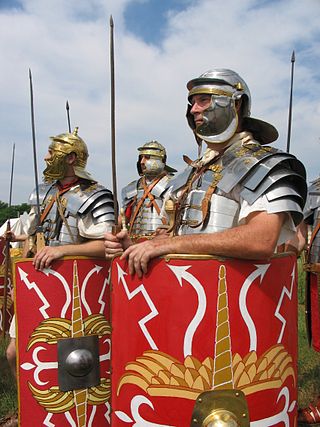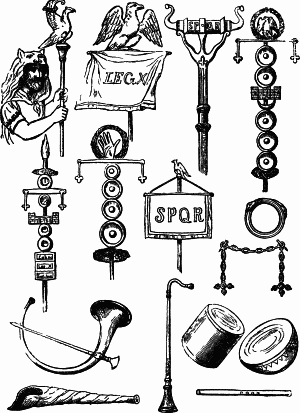The Roman legion, the largest military unit of the Roman army, was composed of Roman citizens serving as legionaries. During the Roman Republic the manipular legion comprised 4,200 infantry and 300 cavalry. After the Marian reforms in 107 BC, the legions were formed of 5,200 men and were restructured around 10 cohorts, the first cohort being double strength. This structure persisted throughout the Principate and middle Empire, before further changes in the fourth century resulted in new formations of around 1,000 men.
The pilum was a javelin commonly used by the Roman army in ancient times. It was generally about 2 m long overall, consisting of an iron shank about 7 mm (0.28 in) in diameter and 600 mm (24 in) long with a pyramidal head, attached to a wooden shaft by either a socket or a flat tang.

Military recruit training, commonly known as basic training or boot camp, refers to the initial instruction of new military personnel. It is a physically and psychologically intensive process, which resocializes its subjects for the unique demands of military employment.

De re militari, also Epitoma rei militaris, is a treatise by the Late Latin writer Publius Flavius Vegetius Renatus about Roman warfare and military principles as a presentation of the methods and practices in use during the height of the Roman Empire and responsible for its power. The extant text dates to the 5th century AD.

The Roman legionary was a citizen soldier of the Roman army. These soldiers would conquer and defend the territories of ancient Rome during the late Republic and Principate eras, alongside auxiliary and cavalry detachments. At its height, Roman legionaries were viewed as the foremost fighting force in the Roman world, with commentators such as Vegetius praising their fighting effectiveness centuries after the classical Roman legionary disappeared.
A cohort was a standard tactical military unit of a Roman legion. Although the standard size changed with time and situation, it was generally composed of 480 soldiers. A cohort is considered to be the equivalent of a modern military battalion. The cohort replaced the maniple. From the late second century BC and until the middle of the third century AD, ten cohorts made up a legion. Cohorts were named "first cohort", "second cohort", etc. The first cohort consisted of experienced legionaries, while the legionaries in the tenth cohort were less experienced.

In the Roman Republic and the Roman Empire, the Latin word castrum was a military-related term. In Latin usage, the singular form castrum meant 'fort', while the plural form castra meant 'camp'. The singular and plural forms could refer in Latin to either a building or plot of land, used as a fortified military base. In English usage, castrum commonly translates to "Roman fort", "Roman camp" and "Roman fortress". However, scholastic convention tends to translate castrum as "fort", "camp", "marching camp" or "fortress".
Maniple was a tactical unit of the Roman Republican armies, adopted during the Samnite Wars. It was also the name of the military insignia carried by such units.
Roman siege engines were, for the most part, adapted from Hellenistic siege technology. Relatively small efforts were made to develop the technology; however, the Romans brought an unrelentingly aggressive style to siege warfare that brought them repeated success. Up to the first century BC, the Romans utilized siege weapons only as required and relied for the most part on ladders, towers and rams to assault a fortified town. Ballistae were also employed, but held no permanent place within a legion's roster, until later in the republic, and were used sparingly. Julius Caesar took great interest in the integration of advanced siege engines, organizing their use for optimal battlefield efficiency.

In the Roman army during classical antiquity, a centurion, was a commander, nominally of a century, a military unit originally consisting of 100 legionaries. The size of the century changed over time; from the 1st century BC through most of the imperial era it was reduced to 80 men.

Foot drill is a part of the training regimen of organized military and paramilitary elements worldwide. It is also practiced by other public services such as police forces, fire and ambulance services. "Foot drill" or "Drill" stems from time since antiquity when soldiers would march into battle, be expected to gather in a formation, and react to words of command from their commanders once the battle commenced. Much of the drill done today is either ceremonial or implemented as a core part of training in the armed forces. Though its practical application on the battlefield has faded, modern militaries justify the use of drill with the claim that it enhances military discipline, as it requires instant obedience to commands and synchronized completion of said commands with the others in the unit.

Plumbatae or martiobarbuli were lead-weighted darts carried by infantrymen in Antiquity and the Middle Ages. They were used to inflict damage on enemies at a distance before engaging in close combat. Roman soldiers in some legions carried plumbatae inside their shields, which allowed them to have ranged weapons similar to arrows, according to Vegetius in his 4th-century military treatise De re militari.

Roman military personal equipment was produced in large numbers to established patterns, and used in an established manner. These standard patterns and uses were called the res militaris or disciplina. Its regular practice during the Roman Republic and Roman Empire led to military excellence and victory. The equipment gave the Romans a very distinct advantage over their "barbarian" enemies, especially so in the case of armour. This does not mean that every Roman soldier had better equipment than the richer men among his opponents. Roman equipment was not of a better quality than that used by the majority of Rome's adversaries. Other historians and writers have stated that the Roman army's need for large quantities of "mass produced" equipment after the so-called "Marian Reforms" and subsequent civil wars led to a decline in the quality of Roman equipment compared to the earlier Republican era:
The production of these kinds of helmets of Italic tradition decreased in quality because of the demands of equipping huge armies, especially during civil wars...The bad quality of these helmets is recorded by the sources describing how sometimes they were covered by wicker protections, like those of Pompeius' soldiers during the siege of Dyrrachium in 48 BC, which were seriously damaged by the missiles of Caesar's slingers and archers.
It would appear that armour quality suffered at times when mass production methods were being used to meet the increased demand which was very high the reduced size cuirasses would also have been quicker and cheaper to produce, which may have been a deciding factor at times of financial crisis, or where large bodies of men were required to be mobilized at short notice, possibly reflected in the poor-quality, mass produced iron helmets of Imperial Italic type C, as found, for example, in the River Po at Cremona, associated with the Civil Wars of AD 69 AD; Russell Robinson, 1975, 67
Up until then, the quality of helmets had been fairly consistent and the bowls well decorated and finished. However, after the Marian Reforms, with their resultant influx of the poorest citizens into the army, there must inevitably have been a massive demand for cheaper equipment, a situation which can only have been exacerbated by the Civil Wars...

United States Army Basic Combat Training (BCT) is the recruit training program of the United States Army, for service in the U.S. Army, U.S. Army Reserve, or the Army National Guard.

In modern scholarship, the "late" period of the Roman army begins with the accession of the Emperor Diocletian in AD 284, and ends in 480 with the death of Julius Nepos, being roughly coterminous with the Dominate. During the period 395–476, the army of the Roman Empire's western half progressively disintegrated, while its counterpart in the East, known as the East Roman army remained largely intact in size and structure until the reign of Justinian I.

A loaded march is a relatively fast march over distance carrying a load and is a common military exercise.

The Roman army of the mid-Republic, also called the manipular Roman army or the Polybian army, refers to the armed forces deployed by the mid-Roman Republic, from the end of the Samnite Wars to the end of the Social War. The first phase of this army, in its manipular structure, is described in detail in the Histories of the ancient Greek historian Polybius, writing before 146 BC.
Roman infantry tactics are the theoretical and historical deployment, formation, and manoeuvres of the Roman infantry from the start of the Roman Republic to the fall of the Western Roman Empire. The original Roman army was made up of hoplites, whose main strategy was forming into a phalanx. By the early third century BCE, the Roman army would switch to the maniple system, which would divide the Roman army into three units, hastati, principes, and triarii. Later, in 107 BCE, Marius would institute the so-called Marian reforms, creating the Roman legions. This system would evolve into the Late Roman Army, which utilized the comitatenses and limitanei units to defend the Empire.

Physical training has been present in some human societies throughout history. Usually, people trained to prepare for physical competition or display, to improve physical, emotional and mental health, and to look attractive. The activity took a variety of different forms but quick dynamic exercises were favoured over slow or more static ones. For example, running, jumping, wrestling, gymnastics and throwing heavy stones are mentioned frequently in historical sources and emphasised as being highly effective training-methods. Notably, they are also forms of exercise which are readily achievable for most people to some extent or another.












